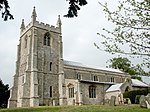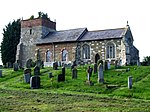Wainfleet railway station

Wainfleet railway station serves the town of Wainfleet All Saints in Lincolnshire, England. The station has its own signal box at the east end of the platforms, which is next to the level crossing. Wainfleet station is 5 miles (8 km) west of Skegness on the Skegness - Grantham - Nottingham Poacher Line. The station is now owned by Network Rail and managed by East Midlands Railway who provide all rail services. The station is unstaffed and offers limited facilities other than two shelters, bicycle storage, timetables and modern 'Help Points'. The full range of tickets for travel are purchased from the guard on the train at no extra cost, there are no retail facilities at this station.
Excerpt from the Wikipedia article Wainfleet railway station (License: CC BY-SA 3.0, Authors, Images).Wainfleet railway station
Station Road, East Lindsey
Geographical coordinates (GPS) Address Nearby Places Show on map
Geographical coordinates (GPS)
| Latitude | Longitude |
|---|---|
| N 53.105 ° | E 0.235 ° |
Address
Station Road
Station Road
PE24 4LQ East Lindsey
England, United Kingdom
Open on Google Maps








